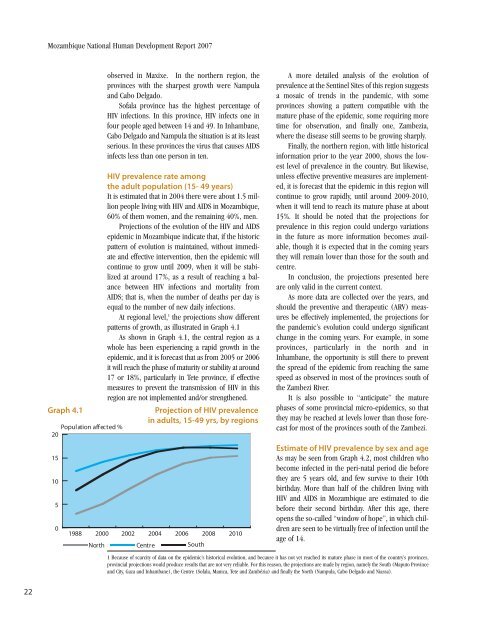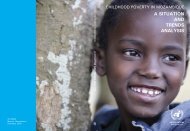English language version - Human Development Reports - United ...
English language version - Human Development Reports - United ...
English language version - Human Development Reports - United ...
- No tags were found...
You also want an ePaper? Increase the reach of your titles
YUMPU automatically turns print PDFs into web optimized ePapers that Google loves.
Mozambique National <strong>Human</strong> <strong>Development</strong> Report 2007Graph 4.1Population affected %2015105019882000observed in Maxixe. In the northern region, theprovinces with the sharpest growth were Nampulaand Cabo Delgado.Sofala province has the highest percentage ofHIV infections. In this province, HIV infects one infour people aged between 14 and 49. In Inhambane,Cabo Delgado and Nampula the situation is at its leastserious. In these provinces the virus that causes AIDSinfects less than one person in ten.HIV prevalence rate amongthe adult population (15- 49 years)It is estimated that in 2004 there were about 1.5 millionpeople living with HIV and AIDS in Mozambique,60% of them women, and the remaining 40%, men.Projections of the evolution of the HIV and AIDSepidemic in Mozambique indicate that, if the historicpattern of evolution is maintained, without immediateand effective intervention, then the epidemic willcontinue to grow until 2009, when it will be stabilizedat around 17%, as a result of reaching a balancebetween HIV infections and mortality fromAIDS; that is, when the number of deaths per day isequal to the number of new daily infections.At regional level, 1 the projections show differentpatterns of growth, as illustrated in Graph 4.1As shown in Graph 4.1, the central region as awhole has been experiencing a rapid growth in theepidemic, and it is forecast that as from 2005 or 2006it will reach the phase of maturity or stability at around17 or 18%, particularly in Tete province, if effectivemeasures to prevent the transmission of HIV in thisregion are not implemented and/or strengthened.2002Projection of HIV prevalencein adults, 15-49 yrs, by regions20042006North Centre South20082010A more detailed analysis of the evolution ofprevalence at the Sentinel Sites of this region suggestsa mosaic of trends in the pandemic, with someprovinces showing a pattern compatible with themature phase of the epidemic, some requiring moretime for observation, and finally one, Zambezia,where the disease still seems to be growing sharply.Finally, the northern region, with little historicalinformation prior to the year 2000, shows the lowestlevel of prevalence in the country. But likewise,unless effective preventive measures are implemented,it is forecast that the epidemic in this region willcontinue to grow rapidly, until around 2009-2010,when it will tend to reach its mature phase at about15%. It should be noted that the projections forprevalence in this region could undergo variationsin the future as more information becomes available,though it is expected that in the coming yearsthey will remain lower than those for the south andcentre.In conclusion, the projections presented hereare only valid in the current context.As more data are collected over the years, andshould the preventive and therapeutic (ARV) measuresbe effectively implemented, the projections forthe pandemic’s evolution could undergo significantchange in the coming years. For example, in someprovinces, particularly in the north and inInhambane, the opportunity is still there to preventthe spread of the epidemic from reaching the samespeed as observed in most of the provinces south ofthe Zambezi River.It is also possible to “anticipate” the maturephases of some provincial micro-epidemics, so thatthey may be reached at levels lower than those forecastfor most of the provinces south of the Zambezi.Estimate of HIV prevalence by sex and ageAs may be seen from Graph 4.2, most children whobecome infected in the peri-natal period die beforethey are 5 years old, and few survive to their 10thbirthday. More than half of the children living withHIV and AIDS in Mozambique are estimated to diebefore their second birthday. After this age, thereopens the so-called “window of hope”, in which childrenare seen to be virtually free of infection until theage of 14.1 Because of scarcity of data on the epidemic’s historical evolution, and because it has not yet reached its mature phase in most of the country’s provinces,provincial projections would produce results that are not very reliable. For this reason, the projections are made by region, namely the South (Maputo Provinceand City, Gaza and Inhambane), the Centre (Sofala, Manica, Tete and Zambézia) and finally the North (Nampula, Cabo Delgado and Niassa).22
















